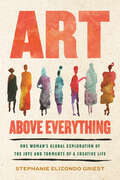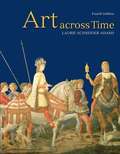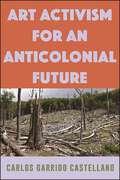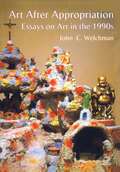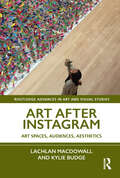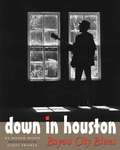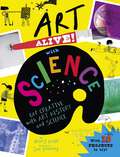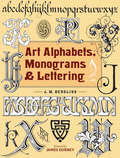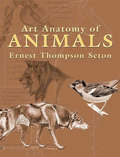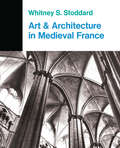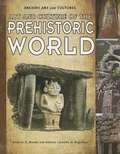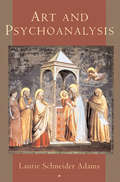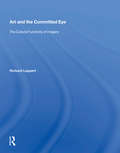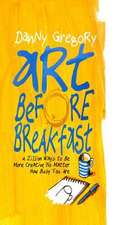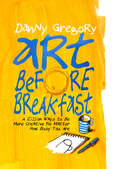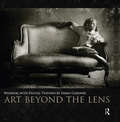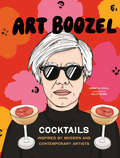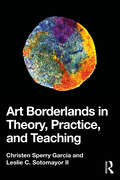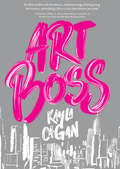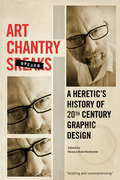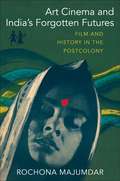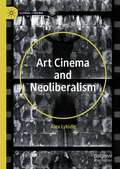- Table View
- List View
Art Above Everything: One Woman's Global Exploration of the Joys and Torments of a Creative Life
by Stephanie Elizondo GriestMeet queer, BIPOC, and women artists around the world as they discuss the gifts, costs, and redemptive power of pursuing a creative lifeIs the all-encompassing quest to become a self-sustaining artist worth the sacrifices it often requires? Throughout her 20s and 30s, Stephanie Elizondo Griest could not help worrying if constantly prioritizing her writing over everything else—from postponing children to living nomadically to save on rent—was leading her to fulfillment or regret. After a break-up and serious health crisis in her early 40s, she decided to turn to other women artists for their perspectives on that perennial question: is art enough?Art Above Everything introduces us to legendary writers, visual artists, dancers, and musicians across the globe, who talk intimately about their art, what it requires, what it gifts them, and what it costs them. Opening in a classical Indian dance village, Elizondo Griest goes on to meet 100+ artists in Rwanda, Romania, Qatar, Iceland, Mexico, New Zealand, Cuba, and the United States. She discovers artists from Rwandan playwright Hope Azeda, who navigated ethnic tensions as she attempted to bring about reconciliation through theater in the aftermath of genocide; to Romanian painter Florica Prevenda, who got assigned to a provincial factory during Ceaușescu&’s dictatorship but never relinquished her brushes.Art is inheritance, dissent, devotion, revenge, celebration, and more. Yet though each artist&’s relationship to their craft is different, their need to create in the face of economic hardship, misogyny, sexual violence, and family ostracization is wholly akin.Bold and inspiring, Art Above Everything never pretends that the artist&’s path is easy—but it illuminates the infinite ways we can wield creativity as a vitalizing force.
Art Across Time Combined (Fourth Edition)
by Laurie Schneider AdamsArt across Time combines sound scholarship, lavish visuals, and a lively narrative to provide students with a comprehensive, accessible, and engaging introduction to Art History. Popular with majors and non-majors alike, the text offers readers more than a chronology of art by placing each work within the time-and-place context within which it was created. <P><P>Encountering and interpreting a work of art in context offers the reader the richest possible experience of it. Large scale and high quality visual reproductions of artworks are often presented from multiple perspectives to enhance visual appeal and allow students to view details and elements of composition with greater ease. A thoughtful pedagogical approach helps students consider what they are viewing.
Art Activism for an Anticolonial Future (SUNY series, Praxis: Theory in Action)
by Carlos Garrido CastellanoAnalyzing the confluence between coloniality and activist art, Art Activism for an Anticolonial Future argues that there is much to gain from approaching contemporary politically committed art practices from the angle of anticolonial, postcolonial, and decolonial struggles. These struggles inspired a vast yet underexplored set of ideas about art and cultural practices and did so decades before the acceptance of radical artistic practices by mainstream art institutions. Carlos Garrido Castellano argues that art activism has been confined to a limited spatial and temporal framework—that of Western culture and the modernist avant-garde. Assumptions about the individual creator and the belated arrival of derivative avant-garde aesthetics to the periphery have generated a narrow view of “political art” at the expense of our capacity to perceive a truly global alternative praxis. Garrido Castellano then illuminates such a praxis, focusing attention on socially engaged art from the Global South, challenging the supposed universality of Western artistic norms, and demonstrating the role of art in promoting and configuring a collective critical consciousness in postcolonial public spheres.This book is freely available in an open access edition thanks to Knowledge Unlatched—an initiative that provides libraries and institutions with a centralized platform to support OA collections and from leading publishing houses and OA initiatives. Learn more at the Knowledge Unlatched website at: https://www.knowledgeunlatched.org/, and access the book online at the SUNY Open Access Repository at http://hdl.handle.net/20.500.12648/7166.
Art After Appropriation: Essays on Art in the 1990s
by John C. WelchmanBeginning with the first comprehensive account of the discourse of appropriation that dominated the art world in the late 1970s and 1980s, Art After Appropriation suggests a matrix of inflections and refusals around the culture of taking or citation, each chapter loosely correlated with one year of the decade between 1989 and 1999. The opening chapters show how the Second World culture of the USSR gave rise to a new visibility for photography during the dissolution of the Soviet Union around 1989. Welchman examines how genres of ethnography, documentary and travel are crossed with fictive performance and social improvisation in the videos of Steve Fagin. He discusses how hybrid forms of subjectivity are delivered by a new critical narcissism, and how the Korean-American artist, Cody Choi converts diffident gestures of appropriation from the logic of material or stylistic annexation into continuous incorporated events. Art After Appropriation also examines the creation of public art from covert actions and social feedback, and how bodies participate in their own appropriation. Art After Appropriation concludes with the advent of the rainbow net, an imaginary icon that governs the spaces of interactivity, proliferation and media piracy at the end of the millennium.John Welchman is Professor of Modern Art History, Theory and Criticism at the University of California, San Diego. He is the author of Modernism Relocated (1995) and Invisible Colors (1997); and editor of Rethinking Borders (1996), and a forthcoming three-volume anthology of the writings of LA artist MIke Kelley. Welchman has contributed to numerous journals, magazines, museum catalogues and newspapers, including Artforum; New York Times; Los Angeles Times; International Herald Tribune; Los Angeles County Museum of Art; Tate Gallery; Museum of Contemporary Art, Los Angeles; Reina Sofia, Madrid; Haus der Kunst, Munich
Art After Instagram: Art Spaces, Audiences, Aesthetics (Routledge Advances in Art and Visual Studies)
by Lachlan MacDowall Kylie BudgeThis book explores the effects of the Instagram platform on the making and viewing of art. Authors Lachlan MacDowall and Kylie Budge critically analyse the ways Instagram has influenced artists, art spaces, art institutions and art audiences, and ultimately contemporary aesthetic experience. The book argues that more than simply being a container for digital photography, the architecture of Instagram represents a new relationship to the image and to visual experience, a way of shaping ocular habits and social relations. Following a detailed analysis of the structure of Instagram – the tactile world of affiliation (‘follows’), aesthetics (‘likes’) and attention (‘comments’) – the book examines how art spaces, audiences and aesthetics are key to understanding its rise. The book will be of interest to scholars working in art history, design, digital culture, cultural studies, sociology, education, business, media and communication studies.
Art After Instagram: Art Spaces, Audiences, Aesthetics (Routledge Advances in Art and Visual Studies)
by Lachlan MacDowall Kylie BudgeThis book explores the effects of the Instagram platform on the making and viewing of art.Authors Lachlan MacDowall and Kylie Budge critically analyse the ways Instagram has influenced artists, art spaces, art institutions and art audiences, and ultimately contemporary aesthetic experience. The book argues that more than simply being a container for digital photography, the architecture of Instagram represents a new relationship to the image and to visual experience, a way of shaping ocular habits and social relations. Following a detailed analysis of the structure of Instagram – the tactile world of affiliation (‘follows’), aesthetics (‘likes’) and attention (‘comments’) – the book examines how art spaces, audiences and aesthetics are key to understanding its rise.The book will be of interest to scholars working in art history, design, digital culture, cultural studies, sociology, education, business, media and communication studies.
Art Against Dictatorship: Making and Exporting Arpilleras Under Pinochet
by Jacqueline AdamsArt can be a powerful avenue of resistance to oppressive governments. During the dictatorship of Augusto Pinochet in Chile, some of the country's least powerful citizens-impoverished women living in Santiago's shantytowns-spotlighted the government's failings and use of violence by creating and selling arpilleras, appliquéd pictures in cloth that portrayed the unemployment, poverty, and repression that they endured, their work to make ends meet, and their varied forms of protest. Smuggled out of Chile by human rights organizations, the arpilleras raised international awareness of the Pinochet regime's abuses while providing income for the arpillera makers and creating a network of solidarity between the people of Chile and sympathizers throughout the world. Using the Chilean arpilleras as a case study, this book explores how dissident art can be produced under dictatorship, when freedom of expression is absent and repression rife, and the consequences of its production for the resistance and for the artists. Taking a sociological approach based on interviews, participant observation, archival research, and analysis of a visual database, Jacqueline Adams examines the emergence of the arpilleras and then traces their journey from the workshops and homes in which they were made, to the human rights organizations that exported them, and on to sellers and buyers abroad, as well as in Chile. She then presents the perspectives of the arpillera makers and human rights organization staff, who discuss how the arpilleras strengthened the resistance and empowered the women who made them.
Art Alive! with Science: Get creative with art history and science!
by Mary AuldExperience how art meets science, from the earliest cave paintings to today's advanced tech - and meet the innovative artists behind it all!In Art Alive! with Science, award-winning author Mary Auld explores moments from art history that have expanded our understanding of the way things work, such as the beautiful balance of forces in kinetic sculpture, the interplay of light and shadow in painting and puppetry and how Op Art tricks our brains and plays with our senses. Following each case study of astounding innovation, there is a creative project that applies the scientific learning to the reader's own art practice. The unique art style of illustrator Sue Downing is sure to draw in young artists, especially alongside the photos of each artist's work and contribution to the timeline of innovation. Perfect for children age 8 and up.Artists and science principles inside include:Introduction: Artists and scientists from cave painting to bronze castingThe art of anatomy with Myron's Discobolus (Discus Thrower)The science of illustration with Hildegard of Bingen and Abd al-Rahman al-SufiThe fantasy of flight with Leonardo da VinciThe drama of light with Caravaggio's chiaroscuro and wayang kulit shadow puppetryThe art of nature with Ustad Mansur and Maria Sibylla MerianThe image in perspective with Johannes Vermeer's The GeographerThe science of clouds with Luke Howard, Caspar David Friedrich and John ConstableThe sense of colour with expressionism and pointillismThe structure of flowers with Georgia O'KeeffeThe energy of sound with Paul Klee's PolyphonyThe balance of forces with Alexander Calder's kinetic sculpturesThe art of astronomy with Galileo, Lucien Rudaux and NASAThe art of light with Pablo Picasso, Gjon Mili and their famous light drawing collaborationThe art of illusion with Marina ApollonioThe science of materials with Anish KapoorThe structures of life with Dorothy Hodgkin and Conrad ShawcrossThe reactions of chemistry with Cai Guo-Qiang's explosion eventsThe dimension of time with Jen's Stark's fascinating and mathematical 30 Cubed
Art Alphabets, Monograms, and Lettering (Dover Art Instruction)
by J. M. BerglingChicago–based jewelry engraver J. M. Bergling (1866–1933) created thousands of letter styles, signets, monograms, and ciphers. A noted author on the subjects of lettering and heraldic design, Bergling created books that became standard references of his era. He assembled his first book, Art Monograms and Letters,with the hopes of inspiring other etchers, engravers, sign painters, and artisans. This volume contains selected illustrations from that publication in addition to his complete Art Alphabets and Lettering,which comprises 96 pages of layouts and letter styles ranging from simple to ornate. Commercial artists, designers, calligraphers, engravers, amateurs, and professionals will prize this exclusive edition as a source of high-quality images and alphabets. This reference book features an appreciative Foreword by artist and author James Gurney, which places Bergling's works in historical context.
Art Anatomy of Animals
by Ernest Thompson SetonA prolific author of books on wildlife, the great naturalist Ernest Thompson Seton was also an accomplished illustrator. Noting a dearth of general zoological anatomies for artists, he took it upon himself to create one. This volume is the result of his efforts. In it, he provides a definitive artist's-eye view of the exterior anatomy of animals, helping readers depict surface features such as hair or fur, as well as basic body and facial structures.Chapters cover a number of domesticated and wild species: the anatomy, size, and proportion of the lion, tiger, leopard, and other members of the cat family; bears (including the grizzly, European brown, American black, and the polar bear); as well as the camel, Indian elephant, and the caribou. Additional sections consider the horse in motion, the gallop of a dog, and bird feathering.One of the most widely consulted books on the subject, Art Anatomy of Animals will be a valuable addition to the libraries of both instructors and students of art.
Art And Architecture In Medieval France: Medieval Architecture, Sculpture, Stained Glass, Manuscripts, The Art Of The Church Treasuries
by Whitney S. StoddardThis is an English-language study on the architecture and art of medieval France of the Romanesque and Gothic periods between 1000-1500. In addition to essays on individual monuments there are general discussions of given periods and specific problems such as: why did Gothic come into being? Whitney Stoddard explores the interrelationship between all forms of medieval ecclesiastical art and characterization of the Gothic cathedral, which he believes to have an almost metaphysical basis.
Art And Architecture Of The Middle Ages: Exploring A Connected World
by Linda Safran Jill Caskey Adam S. CohenArt and Architecture of the Middle Ages is a panoramic survey that focuses on the arts of medieval Europe, Byzantium, and the Islamicate world. From majestic monuments to exquisite tableware, Jill Caskey, Adam S. Cohen, and Linda Safran deftly guide readers over twelve centuries of art and architecture created by the diverse peoples and religious groups of western Eurasia and North Africa. This textbook, intended for a wide range of courses in the history of medieval art and architecture, uniquely features: • More than 450 color illustrations of fascinating works produced between ca. 250 CE and ca. 1450 CE • Coverage of secular and religious arts, including polytheistic, Zoroastrian, Jewish, Christian, and Islamic traditions • Informational text boxes on key issues and a glossary of terms • Diverse cultures interwoven in a single chronological framework • Five broad interpretive themes―artistic production, status and identity, connection to the past, ideology, and access to the sacred Complemented by a website (artofthemiddleages.com) with additional works, dynamic maps and timelines, podcasts, new primary-source translations, and more, Art and Architecture of the Middle Ages brilliantly expands and recalibrates the story of medieval art history.
Art And Culture Of The Prehistoric World
by Beatrice D. Brooke Roberto Carvalho de MagalhãesWe know a surprising amount about how people lived before the written word. This strikingly visual book combines photographs of artifacts created by ancient humans with brilliant illustrations, and is guaranteed to appeal to students of all ages. Readers learn about the lives of early humans, from the invention of tools to their religious beliefs. They'll see that we've been a highly inventive species all along.
Art And Psychoanalysis (Icon Editions)
by Laurie Schneider AdamsA pioneering overview of art and psychoanalysis that shows how each field can enrich and enlarge the other.
Art And The Committed Eye: The Cultural Functions Of Imagery
by Richard LeppertIn Art and the Committed Eye Richard Leppert examines Western European and American art from the fifteenth to the twentieth century. He studies the complex relation between the "look" of images and the variety of social and cultural uses to which they are put and demonstrates that the meaning of any image is significantly determined by its function, which changes over time. In particular, he emphasizes the ways in which visual culture is called on to mediate social differences defined by gender, class, and race. In , Leppert addresses the nature and task of representation, discussing how meaning accrues to images and what role vision and visuality play in the history of modernity. Here he explains imagery's power to attract our gaze by triggering desire and focuses on the long history of the use of representation to enact a deception, whether in painting or advertising. explores art's relation to the material world, to the ways in which images mark our various physical and psychic ties to objects. The author analyzes still life paintings whose subject matter is both extraordinarily diverse and deeply paradoxical—from flower bouquets to grotesque formal arrangements of human body parts. Leppert demonstrates that even in "innocent" still lifes, formal design and technical execution are imbued with cultural conflict and social power. is devoted to the representation of the human body—as subject to obsessive gazing and as an object of display, spectacle, and transgression. The variety of body representation is enormous: pleased or tortured, gorgeous or monstrous, modest or lascivious, powerful or weak, in the bloom of life or under the anatomist's knife, clothed or naked. But it is the sexual body, Leppert shows, that has provided the West with its richest, most complex, contradictory, conflicted, and paradoxical accounts of human identity in relation to social ideals.
Art Before Breakfast
by Danny GregoryPacked with the signature can-do attitude that makes beloved artist Danny Gregory a creativity guru to thousands across the globe, this unique guide serves up a hearty helping of inspiration. For aspiring artists who want to draw and paint but just can't seem to find time in the day, Gregory offers 5- to 10-minute exercises for every skill level that fit into any schedule--whether on a plane, in a meeting, or at the breakfast table--along with practical instruction on techniques and materials, plus strategies for making work that's exciting, unintimidating, and fulfilling. Filled with Gregory's encouraging words and motivating illustrations, Art Before Breakfast teaches readers how to develop a creative habit and lead a richer life through making art.
Art Before Breakfast: A Zillion Ways to be More Creative No Matter How Busy You Are
by Danny GregoryPacked with the signature can-do attitude that makes beloved artist Danny Gregory a creativity guru to thousands across the globe, this unique guide serves up a hearty helping of inspiration. For aspiring artists who want to draw and paint but just can't seem to find time in the day, Gregory offers 5– to 10–minute exercises for every skill level that fit into any schedule—whether on a plane, in a meeting, or at the breakfast table—along with practical instruction on techniques and materials, plus strategies for making work that's exciting, unintimidating, and fulfilling. Filled with Gregory's encouraging words and motivating illustrations, Art Before Breakfast teaches readers how to develop a creative habit and lead a richer life through making art.
Art Beyond The West
by Michael Kampen-O'RileyIn this major survey of the arts of Africa, Western and Central Asia, India, Southeast Asia, China, Korea, Japan, the Pacific, and the Americas, author Michael Kampen-O’Riley presents the vast range of arts that lie outside of the Western tradition. Within a predominantly geographic and chronological framework, he explores the arts of these areas from pre-history to present day. The first dedicated survey of “non-Western” art, Art Beyond the West is amply illustrated and accessibly written.
Art Beyond the Lens: Working with Digital Textures
by Sarah GardnerVintage-looking, dream-like textures can open up a whole new world in your photography. However, there is much, much more to working with textures than simply merging them with an image via Photoshop. In this gorgeous new guide from texture guru Sarah Gardner, you'll learn everything there is to know about how to maximize the potential of these exciting tools. In addition to hundreds of beautiful example images, this book is also packed with practical advice on what makes a good texture, and how and when to use them. How an image is initially captured and processed has a significant impact on the effect a texture will have, so you'll also learn what to consider when composing and shooting (rather than simply relying on post-processing) and how to use lighting and background considerations effectively for later work with textures. Workshop notes and a supplemental website will help you put Sarah's techniques into practice immediately. Beautiful enough to sit on your coffee table yet practical enough to store near your computer, this book will show you everything you need to know to get that coveted vintage-feel in your images, whether you're a casual family snapper or a seasoned professional.
Art Boozel: Cocktails Inspired by Modern and Contemporary Artists
by Jennifer CrollRaise a glass to the world's most exciting modern and contemporary artists in this inspired cocktail book with over 50 tribute recipes.Go on a boozy tour of art history with this collection of recipes for over 50 expertly crafted cocktails, each one a unique creation inspired by its namesake artist. Unwind with a refreshing tequila-watermelon Frida Kahlo. Spark some inspiration while sipping on a Salvador Dalí. Or mix it up with a colorfully sweet Yayoi Kusama.From painters to sculptors, photographers, and more, each artist profiled has a cocktail recipe that draws deeply from their life and work. Both art lovers and cocktail enthusiasts alike will love pouring over this collection of engaging stories and unique recipes. Inventive and deliciously fun, ART BOOZEL will give you a new appreciation for each of these inspiring artists.INVENTIVE & FUN RECIPES: Each of these recipes draws from elements of the artist's life and work in colorful ways that any cocktail enthusiast will enjoy; think tomato garnishes in the Andy Warhol, golden turmeric in the Gustav Klimt, and flower syrup in the Georgia O'Keeffe.BESTSELLING TEAM: Jennifer Croll and Kelly Shami, the author and illustrator who brought you the wildly popular FREE THE TIPPLE, are back to deliver more of the colorful cocktail recipes and lush illustration that everyone loves.PERFECT FOR ART LOVERS: Any level of art appreciator will enjoy pouring over the diverse biographies and engaging portraits, and will love creating drinks inspired by their favorite modern and contemporary artists.Perfect for: mixology enthusiasts; art and art history lovers; museum and gallery visitors, especially visitors to SFMOMA, MoMA, and LACMA; readers of Punch, Bon Appétit, Saveur.
Art Borderlands in Theory, Practice, and Teaching
by Christen Sperry García Leslie C. Sotomayor IIResponding to an absence of Latine and Chicane artist and teaching resources, Art Borderlands in Theory, Practice, and Teaching shows how artists and educators can use borderlands, in-between geographical, emotional, cultural, and conceptual spaces, in three ways: theory, art practice, and teaching.Throughout this teaching-oriented text, the authors draw from borderlands theories and apply them to visual art and teaching. This volume centers art making and teaching practices based on borderlands lived experiences that are not commonly taught in higher education. Making productive the rupture and fragmentation that occurs in borderlands spaces, this text explores ways in which artists rebuild and become whole again through the process of making art. Using hands-on approaches, the authors model how to use borderlands theories in the classroom by employing arts-based and teaching methodologies. This includes access to Latine and Chicane centered digital information, interactive classroom activities, artist resources, and beyond the classroom learning experiences.Art Borderlands in Theory, Practice, and Teaching offers artists, students, and educators art making and teaching approaches that are centered on Latine and Chicane theories and concepts.
Art Boss
by Kayla CaganArtist Piper Perish has moved from her hometown of Houston, Texas, to New York City. Her days are spent exploring; her nights are filled with painting. It's her lifelong dream come true . . . . Except life in the city isn't as glamorous as it looks from afar. Piper's high-pressure work as an assistant to a famous modern artist takes away time from her own art. And Piper's new friend Grace, a budding activist, has Piper beginning to wonder if making great art is really enough.In a story that stands alone but can be read as a companion novel to Piper Perish, acclaimed author Kayla Cagan returns with Piper's powerful and utterly authentic journey of growing up into a strong, independent young woman—as she learns how to make life about art, and how to make that art matter. Art Boss will have readers asking big questions along with Piper. What is art for? What can art do? And how can a young artist change the world?
Art Chantry Speaks
by Art Chantry Monica René RochesterThere used to be a time when designers were trained in the history of composition. Now you just buy a fuckin' piece of software and now you've become a designer."Art Chantry . . . Is he a Luddite?" asks a Rhode Island School of Design poster promoting a Chantry lecture. "Or is he a graphic design hero?"For decades this avatar of low-tech design has fought against the cheap and easy use of digital software. Chantry's homage to expired technology, and his inspired use of Xerox machines and X-Acto blade cuts of printed material, created a much-copied style during the grunge period and beyond.Chantry's designs were published in Some People Can't Surf: The Graphic Design of Art Chantry (Chronicle Books), exhibited at the Seattle Art Museum, the Rock and Roll Hall of Fame, the Museum of Modern Art, the Smithsonian, and the Louvre.More recently, Chantry has drawn upon his extraordinary collection of twentieth-century graphic art to create compelling histories of the forgotten and unknown on essays he has posted on his Facebook page. These essays might lionize the unrecognized illustrators of screws, wrenches, and pipes in equipment catalogs. Other posts might reveal how some famous artists were improperly recognized.Art Chantry Speaks is the kind of opinionated art history you've always wanted to read but were never assigned.
Art Cinema and India’s Forgotten Futures: Film and History in the Postcolony
by Rochona MajumdarThe project of Indian art cinema began in the years following independence in 1947, at once evoking the global reach of the term “art film” and speaking to the aspirations of the new nation-state. In this pioneering book, Rochona Majumdar examines key works of Indian art cinema to demonstrate how film emerged as a mode of doing history and that, in so doing, it anticipated some of the most influential insights of postcolonial thought.Majumdar details how filmmakers as well as a host of film societies and publications sought to foster a new cinematic culture for the new nation, fueled by enthusiasm for a future of progress and development. Good films would help make good citizens: art cinema would not only earn global prestige but also shape discerning individuals capable of exercising aesthetic and political judgment. During the 1960s, however, Satyajit Ray, Mrinal Sen, and Ritwik Ghatak—the leading figures of Indian art cinema—became disillusioned with the belief that film was integral to national development. Instead, Majumdar contends, their works captured the unresolvable contradictions of the postcolonial present, which pointed toward possible, yet unrealized futures.Analyzing the films of Ray, Sen, and Ghatak, and working through previously unexplored archives of film society publications, Majumdar offers a radical reinterpretation of Indian film history. Art Cinema and India’s Forgotten Futures offers sweeping new insights into film’s relationship with the postcolonial condition and its role in decolonial imaginations of the future.
Art Cinema and Neoliberalism (Global Cinema)
by Alex LykidisArt Cinema and Neoliberalism surveys cinematic responses to neoliberalism across four continents. One of the first in-depth studies of its kind, this book provides an imaginative reassessment of art cinema in the new millennium by showing how the exigencies of contemporary capitalism are exerting pressure on art cinema conventions. Through a careful examination of neoliberal thought and practice, the book explores the wide-ranging effects of neoliberalism on various sectors of society and on the evolution of film language. Alex Lykidis evaluates the relevance of art cinema style to explanations of the neoliberal order and uses a case study approach to analyze the films of acclaimed directors such as Asghar Farhadi, Yorgos Lanthimos, and Lucrecia Martel in relation to the social, political, and cultural characteristics of neoliberalism. By connecting the aesthetics of art cinema to current social antagonisms, Lykidis positions class as a central concern in our understanding of the polarized dynamics of late capitalism and the escalating provocations of today’s film auteurs.
